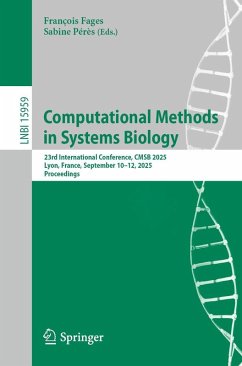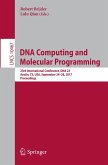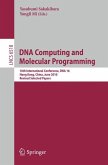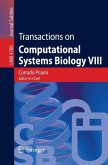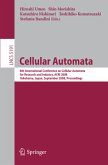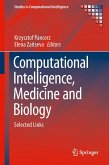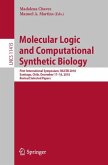Computational Methods in Systems Biology
23rd International Conference, CMSB 2025, Lyon, France, September 10-12, 2025, Proceedings
Herausgegeben:Fages, François; Pérès, Sabine
Computational Methods in Systems Biology
23rd International Conference, CMSB 2025, Lyon, France, September 10-12, 2025, Proceedings
Herausgegeben:Fages, François; Pérès, Sabine
- Broschiertes Buch
- Merkliste
- Auf die Merkliste
- Bewerten Bewerten
- Teilen
- Produkt teilen
- Produkterinnerung
- Produkterinnerung
This book constitutes the refereed proceedings of the 23rd International Conference on Computational Methods in Systems Biology, CMSB 2025, which took place in Lyon, France, during September 10 12, 2025.
The 21 full papers presented in this volume were carefully reviewed and selected from 34 submissions sent to reviews.
They are grouped into the following topics: Boolean Networks; Continuous and Hybrid models; Rule-based models; Model inference and machine learning; Population models and control.
Andere Kunden interessierten sich auch für
![DNA Computing and Molecular Programming DNA Computing and Molecular Programming]() DNA Computing and Molecular Programming38,99 €
DNA Computing and Molecular Programming38,99 €![DNA Computing and Molecular Programming DNA Computing and Molecular Programming]() DNA Computing and Molecular Programming39,99 €
DNA Computing and Molecular Programming39,99 €![Transactions on Computational Systems Biology VIII Transactions on Computational Systems Biology VIII]() Corrado Priami (ed.-in-chief)Transactions on Computational Systems Biology VIII38,99 €
Corrado Priami (ed.-in-chief)Transactions on Computational Systems Biology VIII38,99 €![Multiobjective Optimization Algorithms for Bioinformatics Multiobjective Optimization Algorithms for Bioinformatics]() Anirban MukhopadhyayMultiobjective Optimization Algorithms for Bioinformatics123,99 €
Anirban MukhopadhyayMultiobjective Optimization Algorithms for Bioinformatics123,99 €![Cellular Automata Cellular Automata]() Cellular Automata39,99 €
Cellular Automata39,99 €![Computational Intelligence, Medicine and Biology Computational Intelligence, Medicine and Biology]() Computational Intelligence, Medicine and Biology76,99 €
Computational Intelligence, Medicine and Biology76,99 €![Molecular Logic and Computational Synthetic Biology Molecular Logic and Computational Synthetic Biology]() Molecular Logic and Computational Synthetic Biology38,99 €
Molecular Logic and Computational Synthetic Biology38,99 €-
-
-
This book constitutes the refereed proceedings of the 23rd International Conference on Computational Methods in Systems Biology, CMSB 2025, which took place in Lyon, France, during September 10 12, 2025.
The 21 full papers presented in this volume were carefully reviewed and selected from 34 submissions sent to reviews.
They are grouped into the following topics: Boolean Networks; Continuous and Hybrid models; Rule-based models; Model inference and machine learning; Population models and control.
The 21 full papers presented in this volume were carefully reviewed and selected from 34 submissions sent to reviews.
They are grouped into the following topics: Boolean Networks; Continuous and Hybrid models; Rule-based models; Model inference and machine learning; Population models and control.
Produktdetails
- Produktdetails
- Lecture Notes in Computer Science 15959
- Verlag: Springer / Springer Nature Switzerland / Springer, Berlin
- Artikelnr. des Verlages: 89556680, 978-3-032-01435-1
- Seitenzahl: 428
- Erscheinungstermin: 19. August 2025
- Englisch
- Abmessung: 235mm x 155mm x 24mm
- Gewicht: 645g
- ISBN-13: 9783032014351
- ISBN-10: 3032014352
- Artikelnr.: 74803836
- Herstellerkennzeichnung
- Springer-Verlag KG
- Sachsenplatz 4-6
- 1201 Wien, AT
- ProductSafety@springernature.com
- Lecture Notes in Computer Science 15959
- Verlag: Springer / Springer Nature Switzerland / Springer, Berlin
- Artikelnr. des Verlages: 89556680, 978-3-032-01435-1
- Seitenzahl: 428
- Erscheinungstermin: 19. August 2025
- Englisch
- Abmessung: 235mm x 155mm x 24mm
- Gewicht: 645g
- ISBN-13: 9783032014351
- ISBN-10: 3032014352
- Artikelnr.: 74803836
- Herstellerkennzeichnung
- Springer-Verlag KG
- Sachsenplatz 4-6
- 1201 Wien, AT
- ProductSafety@springernature.com
.- Boolean Networks.
.- Computation of immediate neighbours of monotone Boolean functions.
.- Three-State Gene Expression Model Parameterized for Single-Cell Multi-Omics Data.
.- On Model Reductions of Boolean Networks.
.- AEON 2025: Robust Control of Partially-Specified Boolean Networks (tool paper).
.- Looking for Signs: Reasoning About FOBNNs Using SAT.
.- Continuous Petri Nets Faithfully Fluidify Most Permissive Boolean Networks.
.- Continuous and Hybrid models.
.- Efficient stochastic simulation of gene regulatory networks using hybrid models of transcriptional bursting.
.- Exploring Metastable Dynamics of Gene Regulatory Networks with ISOKANN.
.- Rule-based models.
.- Reachability Analysis for Parametric Rule-Based Models.
.- A rule-based modeling approach for studying animal collectives: a case study of juvenile honeybee thermotaxis.
.- A Formal Approach to Identify Structural Patterns in RNA.
.- Model inference and machine learning.
.- Kolmogorov-Arnold Network for Gene Regulatory Network Inference.
.- Optimal input design for model selection in systems with cell-to-cell variability.
.- Decoding Gene Regulation in Alzheimer s disease with Transfer Learning and Explainable Machine Learning.
.- Influence Graphs of Phytoplankton Species Interactions using Logical Learning.
.- Evaluating PDE discovery methods for multiscale modeling of biological signals.
.- Optimizing Feature Extraction Methods using Class Similarity Ratio for EMG-based Hand Gesture Classification.
.- Population models and control.
.- Eukaryotic ancestry in a finite world.
.- Minimal metabolic exchanges for microbial communities in a chemostat at steady state.
.- Seed inference in interacting microbial communities using combinatorial optimization.
.- A model-free control strategy for selective disruption of parkinsonian brain oscillations.
.- Computation of immediate neighbours of monotone Boolean functions.
.- Three-State Gene Expression Model Parameterized for Single-Cell Multi-Omics Data.
.- On Model Reductions of Boolean Networks.
.- AEON 2025: Robust Control of Partially-Specified Boolean Networks (tool paper).
.- Looking for Signs: Reasoning About FOBNNs Using SAT.
.- Continuous Petri Nets Faithfully Fluidify Most Permissive Boolean Networks.
.- Continuous and Hybrid models.
.- Efficient stochastic simulation of gene regulatory networks using hybrid models of transcriptional bursting.
.- Exploring Metastable Dynamics of Gene Regulatory Networks with ISOKANN.
.- Rule-based models.
.- Reachability Analysis for Parametric Rule-Based Models.
.- A rule-based modeling approach for studying animal collectives: a case study of juvenile honeybee thermotaxis.
.- A Formal Approach to Identify Structural Patterns in RNA.
.- Model inference and machine learning.
.- Kolmogorov-Arnold Network for Gene Regulatory Network Inference.
.- Optimal input design for model selection in systems with cell-to-cell variability.
.- Decoding Gene Regulation in Alzheimer s disease with Transfer Learning and Explainable Machine Learning.
.- Influence Graphs of Phytoplankton Species Interactions using Logical Learning.
.- Evaluating PDE discovery methods for multiscale modeling of biological signals.
.- Optimizing Feature Extraction Methods using Class Similarity Ratio for EMG-based Hand Gesture Classification.
.- Population models and control.
.- Eukaryotic ancestry in a finite world.
.- Minimal metabolic exchanges for microbial communities in a chemostat at steady state.
.- Seed inference in interacting microbial communities using combinatorial optimization.
.- A model-free control strategy for selective disruption of parkinsonian brain oscillations.
.- Boolean Networks.
.- Computation of immediate neighbours of monotone Boolean functions.
.- Three-State Gene Expression Model Parameterized for Single-Cell Multi-Omics Data.
.- On Model Reductions of Boolean Networks.
.- AEON 2025: Robust Control of Partially-Specified Boolean Networks (tool paper).
.- Looking for Signs: Reasoning About FOBNNs Using SAT.
.- Continuous Petri Nets Faithfully Fluidify Most Permissive Boolean Networks.
.- Continuous and Hybrid models.
.- Efficient stochastic simulation of gene regulatory networks using hybrid models of transcriptional bursting.
.- Exploring Metastable Dynamics of Gene Regulatory Networks with ISOKANN.
.- Rule-based models.
.- Reachability Analysis for Parametric Rule-Based Models.
.- A rule-based modeling approach for studying animal collectives: a case study of juvenile honeybee thermotaxis.
.- A Formal Approach to Identify Structural Patterns in RNA.
.- Model inference and machine learning.
.- Kolmogorov-Arnold Network for Gene Regulatory Network Inference.
.- Optimal input design for model selection in systems with cell-to-cell variability.
.- Decoding Gene Regulation in Alzheimer s disease with Transfer Learning and Explainable Machine Learning.
.- Influence Graphs of Phytoplankton Species Interactions using Logical Learning.
.- Evaluating PDE discovery methods for multiscale modeling of biological signals.
.- Optimizing Feature Extraction Methods using Class Similarity Ratio for EMG-based Hand Gesture Classification.
.- Population models and control.
.- Eukaryotic ancestry in a finite world.
.- Minimal metabolic exchanges for microbial communities in a chemostat at steady state.
.- Seed inference in interacting microbial communities using combinatorial optimization.
.- A model-free control strategy for selective disruption of parkinsonian brain oscillations.
.- Computation of immediate neighbours of monotone Boolean functions.
.- Three-State Gene Expression Model Parameterized for Single-Cell Multi-Omics Data.
.- On Model Reductions of Boolean Networks.
.- AEON 2025: Robust Control of Partially-Specified Boolean Networks (tool paper).
.- Looking for Signs: Reasoning About FOBNNs Using SAT.
.- Continuous Petri Nets Faithfully Fluidify Most Permissive Boolean Networks.
.- Continuous and Hybrid models.
.- Efficient stochastic simulation of gene regulatory networks using hybrid models of transcriptional bursting.
.- Exploring Metastable Dynamics of Gene Regulatory Networks with ISOKANN.
.- Rule-based models.
.- Reachability Analysis for Parametric Rule-Based Models.
.- A rule-based modeling approach for studying animal collectives: a case study of juvenile honeybee thermotaxis.
.- A Formal Approach to Identify Structural Patterns in RNA.
.- Model inference and machine learning.
.- Kolmogorov-Arnold Network for Gene Regulatory Network Inference.
.- Optimal input design for model selection in systems with cell-to-cell variability.
.- Decoding Gene Regulation in Alzheimer s disease with Transfer Learning and Explainable Machine Learning.
.- Influence Graphs of Phytoplankton Species Interactions using Logical Learning.
.- Evaluating PDE discovery methods for multiscale modeling of biological signals.
.- Optimizing Feature Extraction Methods using Class Similarity Ratio for EMG-based Hand Gesture Classification.
.- Population models and control.
.- Eukaryotic ancestry in a finite world.
.- Minimal metabolic exchanges for microbial communities in a chemostat at steady state.
.- Seed inference in interacting microbial communities using combinatorial optimization.
.- A model-free control strategy for selective disruption of parkinsonian brain oscillations.

